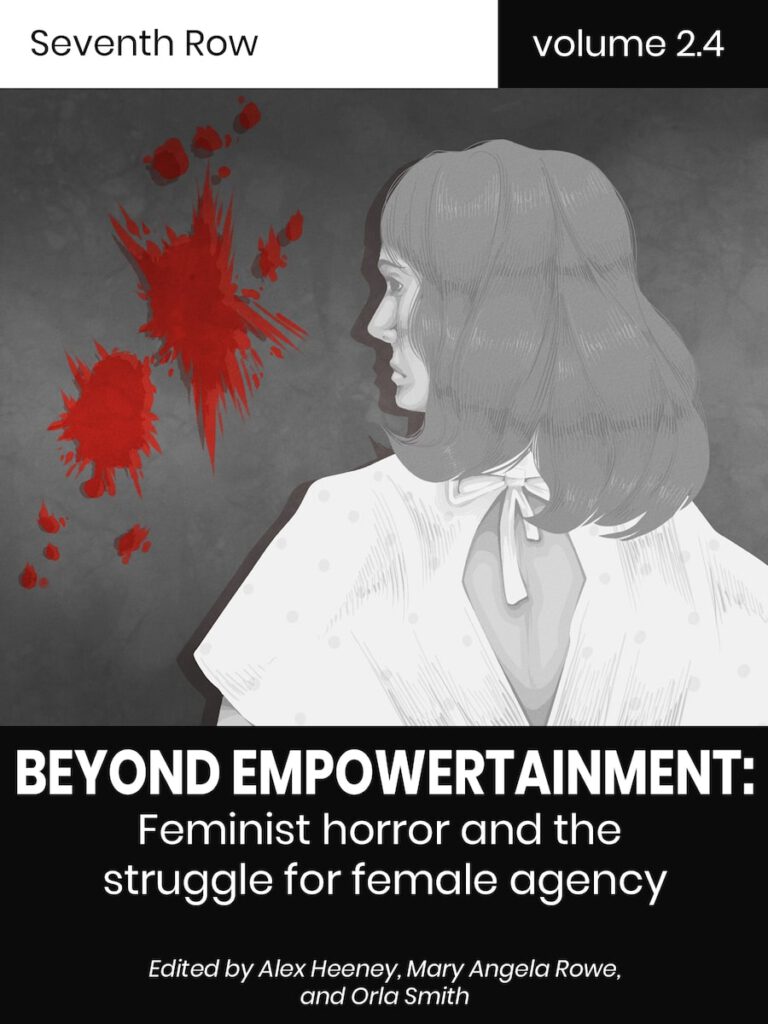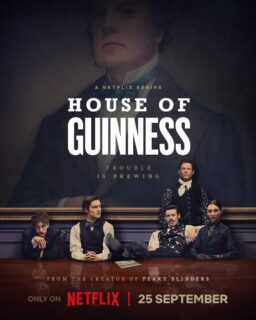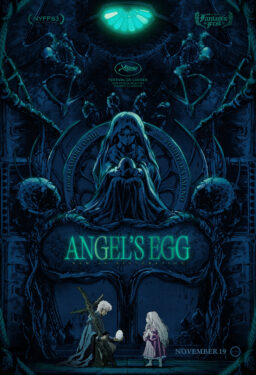Here at RogerEbert.com, we are pleased to offer Mary Angela Rowe’s foreword from the new book Beyond Empowertainment. Below is an introduction from Seventh Row’s press release, and then the foreword.
Beyond Empowertainment: Feminist Horror and the Struggle for Female Agency spotlights a new generation of female-centred horror classics that focus on women’s psychological experience of fear. These films go beyond so-called ‘empowertainment’: stories of women rising up against their oppressors, and in so doing, becoming oppressors themselves. Instead, the feminist horror films in Beyond Empowertainment focus on the horror of the everyday: family trauma, gaslighting, partner violence, and objectification. These films each focus on a single female protagonist and the toll oppression takes on her psyche. The films in Beyond Empowertainment examine the bargains women make in order to survive, and what happens when those bargains become bad deals.
With Beyond Empowertainment, Seventh Row brings its interdisciplinary, technical approach to horror cinema. Seventh Row has previously focused on character-driven, naturalistic dramas. These films featured heightened storytelling to make subtle shifts in identities and relationships visible on-screen: a father and daughter separating in Leave No Trace; a boy’s search for home in Lean on Pete. Horror, as a genre, is a natural extension of Seventh Row’s previous work because it magnifies and externalizes our subconscious fears into forces that can Beyond Empowertainment confronted onscreen. The films in Beyond Empowertainment are horrifying because they ask uncomfortable questions of personal responsibility and complicity that most women must deal with every day.
While Beyond Empowertainment draws on a variety of films to illustrate a new wave in feminist horror, the cornerstone of this book are four case studies: Unsane (2018), Personal Shopper (2016), Thelma (2017), and Raw (2016). These case studies dive deep into the filmmaking choices that make these movies so effective. Each case study features multiple articles that consider each of these films from a variety of different perspectives — interviews with creatives, comparisons, and essay — fostering conversation about films that deserve a place in the horror canon. Most importantly, each case study explores the strong collaboration between director and lead actress that makes each film so effective at getting inside its protagonist’s head.
For horror fans, Beyond Empowertainment provides a new perspective on horror as a genre through reframing classics and incisive analysis of recent horror gems that will be influencing the genre for decades to come. For viewers new to horror, this book illustrates why film lovers should be paying attention to horror and why some feted auteurs are turning to this genre. Taken together, the films discussed in this book reveal a new focus in horror on female agency.
Beyond Empowertainment: Feminist Horror and the Struggle for Female Agency was edited by Alex Heeney, Mary Angela Rowe, and Orla Smith.
Horror is often stereotyped as sexist. It often trades in objectification, and sometimes, outright misogyny. The crude moral code of slasher films is so hostile to women that it’s become a cliché. So how to explain the reality that so many horror fans are female? Scholar Carol Clover argues that both men and women identify with female victims (not male aggressors), and that women feel vicarious power through the triumph of the “final girl”. Critic Gita Jackson says women are attracted to horror films because they tell us our fears are real, and force viewers to experience women’s real-life fears through empathizing with onscreen victims. Similarly, critic Sady Doyle contends that horror films provide a vehicle for women to process and talk about their experiences of violence in a way that’s depersonalized (safe) and not necessarily inflected with the politically-charged language of feminism. In other words, for some women, the misogyny of horror may be part of why we turn to it in the first place: from slut-shamed victims to final girls, horror is a genre that speaks to women’s lived experiences.
Seventh Row has not often focused on genre films, but we observed the way filmmakers we love have turned toward horror as the best vehicle for the stories they are interested in telling. In recent years, auteurs and festival darlings like Luca Guadagnino, Olivier Assayas, and Joachim Trier have tried their hand at horror films. Get Out (Jordan Peele) was nominated for the Academy Award for Best Picture in 2018, further suggesting that horror is leaving the genre-film ghetto. The phrase “elevated horror” has become common for horror films that are also critical darlings (as though the rest of horror was a distasteful morass from which good movies must be rescued). Elevated horror seems to be the label slapped on scary movies that are really ‘about’ something else. But all horror movies scare us because they tap into our fears from real life. The heightened world of horror, the audience’s suspension of disbelief, and the visceral experience of fear are all potent dramatic tools for filmmakers portraying complex characters and emotional extremes. The filmmakers in Beyond Empowertainment chose to use those tools to vividly portray the internal experiences of women.
As a by-product of those vivid internal portrays, the horror films in Beyond Empowertainment are also almost all character studies. Each film focuses on one woman and her choices in the face of threatening circumstances. By necessity, each of these films is anchored by a strong central performance. These actors are tasked with conveying a character’s emotional extremes — rage, terror, elation, despair — while maintaining a grip on the character’s psychological realism, her essential believability. The strong, nuanced performances of Eili Harboe, Claire Foy, and Garance Marillier, to name a few, are key to what sets these stories apart. The movies in this book dive deep into the inner conflicts and experiences of their female main characters, whose fears and struggles are made manifest by the horror setting.
Feminist horror: an incomplete study of the struggle for agency
Feminist writing on horror films has moved into the critical mainstream. Search results for “feminist horror” produce a torrent of results from within the past five years. This recent (and welcome) focus on feminism in horror emerged at the same time as the valorization of female monsters, or monstrous women. Female monsters have been rebranded from abhorrent and unnatural to brave and intrepid, violators of moral and gender norms who are feared and loathed for their power. Here, monstrosity is oppositional: a characterization imposed on ‘deviant’ or rebellious women by a hostile, patriarchal world. Yet this reading may celebrate women simply for being monstrous — mistaking “power” for “empowerment”. Horror films where individual women take bloody, indiscriminate revenge on their oppressors may give us a rush of vicarious satisfaction, but they also verge on empowertainment.
That’s an equivalence the films in Beyond Empowertainment resist. This book collects writing on horror films with female protagonists whose terror often springs from internal struggles: madness, uncontrollable appetites, ambition, or the desire to survive, rather than knife-wielding killers, school bullies, or supernatural forces. These films employ the tropes and mechanisms of horror to pose complicated questions about the degree of harm the protagonists have caused, and how responsible they were for their actions. They plumb the depths of their protagonists, asking us who these women really are and how their gender has shaped their experiences. Sometimes, violence against women is a villain; sometimes, it’s a backdrop; sometimes, it’s a red herring. In all cases, the filmmakers caution that retaliation doesn’t make you better, and it may make you worse. The women at the centre of these movies are linked by their fear of their own capacity for destruction.
Beyond Empowertainment does not purport to exhaustively examine feminist horror; instead, Seventh Row aims to contribute to the critical conversation by highlighting some recent horror movies that are essentially character studies of the female protagonist. She is at once victim and perpetrator, occasionally of violence against herself. Bypassing the experience of victimhood, the characters in these films are largely in conflict with themselves or their own choices. The oppressive reality of life under patriarchy is omnipresent — these women aren’t making choices in a vacuum, and sometimes, their internal conflict springs from resolving tensions or contradictions imposed on them. Often they are left deciding between a number of bad options. Nevertheless, what unites the women in these disparate movies is their need for control over their bodies and their lives. In a genre often dismissed for objectifying women, these female protagonists strive to be subjects, each the centre of her own story.
Why horror? How these feminist films leverage genre
The feminist horror films in Beyond Empowertainment leverage the conventions of horror to disorient the viewer, giving us new insight into each film’s central character. Many of these films are connected to touchstones of the genre. Thelma (Joachim Trier, 2017) reads as an updated Carrie (Brian De Palma, 1976); Unsane (Steven Soderbergh, 2018) parallels Charlotte Perkins Gilman’s short story The Yellow Wallpaper; Raw (Julia Ducournau, 2016) echoes Ginger Snaps (John Fawcett, 2000) and Jennifer’s Body (Karyn Kusama, 2009). Unsane and The Yellow Wallpaper each tell the story of an intelligent young woman who is coerced into confinement and psychiatric treatment, even though she insists this is actually making her worse. The person doing the coercing is a sort of romantic partner who wields the authority of the medical establishment (a stalker who works as an orderly in Unsane; the protagonist’s husband who is a doctor in The Yellow Wallpaper). In both these texts, the protagonists are systematically gaslit and punished via psychiatric treatment for their unwillingness to conform to traditional gender roles. Raw, Ginger Snaps, and Jennifer’s Body each focus on an intense, eroticised relationship between two women (sisters in Raw and Ginger Snaps; sapphic best friends in Jennifer’s Body), and how that relationship changes when one of them becomes a literal man-eater who starts chowing down on the local male population.
Considering these recent films against the backdrop of their horror progenitors highlights not just the similarities, but the gaps between them. Such comparisons throw into sharp relief the way horror itself has changed, as well as how differently these feminist horror films present their female protagonists. Most of the original texts listed above end tragically. The modern reminaginings are more ambiguous, and the women involved have much more scope to choose their own endings.
The rape-revenge subgenre of horror can be cathartic for women viewers, but it can also be alienating, relying on stereotypes about sexual assault and valorizing individual vengeance at the expense of systemic change. Both Revenge (Coralie Fargeat, 2017) and Prevenge (Alice Lowe, 2016) use the conventions of the rape-revenge film to question the very assumptions underpinning this horror sub-genre. Jen, the protagonist in Revenge would probably die first in an ‘80s slasher movie, but the film refuses to punish her for being a “bad girl”, and instead, insists that no-one could ever deserve what happened to her. Prevenge seems like a standard revenge narrative but with a twist — an evil foetus urging homicide from within the pregnant protagonist — until we realize that Ruth isn’t on a righteous quest for vengeance, and our understanding of her narrative goes off the rails. In both cases, the filmmakers lean on conventions of the rape-revenge film to build up our expectations and then subvert them.
In keeping with horror’s newly-burnished critical image, the rape-revenge narrative has crossed the borders of genre film and into mainstream drama. Two recent dramas — the movie Elle (Paul Verhoeven, 2016) and the first season of Big Little Lies (Jean-Marc Vallée, 2017) — also leverage the conventions of the rape-revenge plot to lampshade the ways it stereotypes women, and cast doubt on the implicit promise that individual vengeance will make women feel safer. Looking at these dramatic takes in the context of their horror progenitors, it becomes clear how much these modern psychological examinations of sexual trauma owe to (and/or are reacting against) the familiar rape-and-revenge story propagated in horror. The success of Big Little Lies and Elle illustrates the way modern dramatic filmmakers are employing the tropes and conventions of horror to tell empathetic and meaningful stories about women outside of the genre.
Madness has become nearly a horror cliche: are there ghosts or is she crazy? (It is almost invariably a “she” whose perspective we are led to distrust.) The prospect of the heroine’s madness is much more frightening than any supernatural threat. Yet the root of women’s madness in Perfect Blue (Satoshi Kon, 1997) and Unsane is unambiguous and concrete: these two very different films each explore the psyche of a victim of stalking. Stalking is an attempt to overwrite the victim’s personality and identity by insisting on a relationship that doesn’t exist, or by punishing her for living in a way the stalker considers out of line. It is a kind of gaslighting by force.
Perfect Blue and Unsane both resist the trope of the stalker as a lone nut in an eroticised relationship with his victim, wherein the audience enjoys a voyeuristic thrill at the stalking itself and then feels satisfied that the threat can be contained when the stalker is vanquished. Instead, both Mima (voiced by Junko Iwao) in Perfect Blue and Sawyer (Claire Foy) in Unsane experience stalking as just one very extreme manifestation of misogyny — an embodiment of the objectification and gaslighting that wear them down from all corners every day. Madness, for these women, is the result of life in a patriarchal system where none of their choices are good.
“Madness” is also a label often applied to people making irrational choices because they’re faced with irrational situations. Depending on the perspective of the viewer, those choices can either seem brave or horrifying. That’s the issue Orla Smith tackles in her essay on female monsters, where she compares three films recently held up as empowering or feminist: Ex Machina (Alex Garland, 2014), Lady Macbeth (William Oldroyd, 2016), and Beast (Michael Pearce, 2017). In each of these films, the female protagonist lashes out with violence at those around her, murdering in service of her own desires. These films know their leads are not normal, but we are supposed to root for them anyway: homicide is a rational response to the irrational situation of life under patriarchy. But these protagonists’ cold calculation is driven by straightforwardly selfish motives and a lack of complex inner life. The same can’t be said of Saint Maud (Rose Glass, 2019), a modern-day religious horror film about a fanatical young nurse determined to save the soul of an alluring, difficult, and hedonistic cancer patient. Maud’s madness may be religious ecstasy or demonic possession or merely personal obsession, but the film always leaves open the possibility that Maud is, in fact, in touch with the divine.
Since horror reflects back what we fear, many horror texts have translated our anxiety about new technologies. Cam (Daniel Goldbaher, 2018) and Personal Shopper (Olivier Assayas, 2017) are different: these films focus on why the main character was attracted to a technological development in the first place. Cam takes a feminist look at sex work by exploring what happens when camgirl Alice’s account is hijacked by her doppelganger, who turns out to be more popular than the original. The semi-anonymity of online identity and the live-through-video experience of camming are simulacra of reality masquerading as the real thing — much like the replica who takes over the camgirl account, and in some ways, like sex work itself. In Personal Shopper, Maureen’s relationship with an anonymous texter is mediated entirely through her phone, and she becomes increasingly absorbed in the device at the expense of real life. But Maureen’s relationship with her mysterious texter is alluring precisely because it is mediated through a machine: Maureen is paralyzed by grief over the death of her brother, and her phone allows her to feel connected and alive without ever actually connecting. Both women experience identity as something that can be performed and then stopped — in Alice’s case by turning off her camera; in Maureen’s case, by changing her clothes. But ‘you’ keeps going after you have stopped streaming or changed back into sweatpants. Alice and Maureen find that technology doesn’t provide much of a buffer between the parts of themselves they want to show and the desires or emotions they want to avoid.
These films emphasize how technology has allowed threats to become incorporeal, and how Alice and Maureen are feeding incorporeal versions of themselves. It’s almost an inversion of the slasher film, where the threat is present and palpable and bodily, and the knife is an allegory of sexual penetration. Although Cam and Personal Shopper both engage with how their protagonists’ identities are rooted in their bodies (Cam more explicitly, in every sense of the word), these films are more about existential crises than any more literal anxiety. If Alice never recovers her camgirl account from her doppelganger, her real life will likely go on, largely unimpeded, but she’s poured so much of herself into the creation of her camgirl persona that Alice feels like she’s fighting for her identity. In Maureen’s case, grief and depression have caused her to withdraw from the world and stop caring for herself — she only starts to take pleasure in life once she engages with the anonymous texter, trying on forbidden clothes and pursuing a thrilling correspondence with a texter that she doesn’t recognize. As Alice and Maureen construct selves and relationships that only exist via wireless communication, those selves become increasingly distant from the women they are in real life.
Finally, many horror texts focus on the turmoil of adolescence, expressing cultural anxieties about a girl’s growth from child (object) into woman (potential subject). One established narrative, played out in films from The Exorcist (William Friedkin, 1973) to Ginger Snaps, focuses on puberty — physical and sexual maturation — as the site of horror: a girl’s body becomes threatening to the world around her as she makes the transition into womanhood. But the coming-of-age horror films in Beyond Empowertainment focus less on women’s bodies and more on the fact that growing up means leaving your family behind you. In Thelma, Raw, We Are What We Are (Jim Mickle, 2013), and The Little Girl Who Played With Matches Too Much (Simon Lavoie, 2017), danger doesn’t lurk in the dark woods; it is in your living room, and maybe it even loves you. For the girls and women at the centre of these films, coming of age means confronting the menacing legacy their parents have passed down to them, in the form of trauma or in their blood. The protagonist’s body is often a source of conflict, but that conflict is either imposed upon her by her parents, or else it’s a part of her biological heritage that she’s never been prepared to deal with. Bodily changes and sexual maturity may be the catalyst, but these films refuse even to suggest that a woman’s body is inherently monstrous or threatening. Instead, the family itself is the locus of horror, and family ties must be severed (by force, if necessary) for the female protagonists to grow up.
The women in the films discussed in Beyond Empowertainment: Feminist Horror and the Struggle For Female Agency are in conflict with themselves and their own choices. They are surrounded by forces that want to control them, through methods ranging from love or manipulation (Thelma) to bodily imperatives (Raw, Prevenge) to brutal sexual violence (Revenge). These disparate films, organized around several central themes, have a lot in common. To illustrate most clearly how horror conventions are deployed, we selected four films to be case studies within this book. Unsane, Personal Shopper, Thelma, and Raw are covered by multiple articles considering each of these films from a variety of different perspectives — interviews with creatives, think pieces, comparisons, and essays. These case studies allow us to dive deep into the filmmaking choices that make these movies so effective, while also fostering conversation about films that should really be getting more attention. These four films gave us particular insight into how current filmmakers are using horror to tell feminist stories, reflecting women’s fears as their characters struggle for control and self-determination.
*The women characters in the films of this book are generally portrayed as cisgender. However, the writers and editors of this book intend the terms “women” and “female” to be inclusive, encompassing all people who significantly identify as female.
Find out more about the ebook at: http://feministhorrorbook.com
Listen to our podcast episode on feminist horror and the ebook Beyond Empowertainment here.
Read excerpts from the book here.
Read Seventh Row here.
About Seventh Row:
Seventh Row is an online Canadian Non-Profit publication that releases six highly-focused ebooks a year, each focusing on a film, director, or theme in cinema we’re passionate about. Through in-depth interviews and well-researched essays, we demystify the myriad technical choices behind films we love. Seventh Row is supported entirely by ebook sales and donations.
Where to Find Seventh Row:
Website: http://seventh-row.com
Podcast: https://seventh-row.com/category/podcasts/
Twitter: https://twitter.com/SeventhRow
Facebook: https://www.facebook.com/TheSeventhRow/
Instagram: https://instagram.com/SeventhRow











